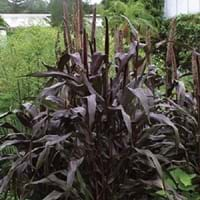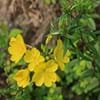Life Span
Perennial
Annual and Perennial
Origin
Northeastern United States, Mid-Atlantic United States, Southeastern United States, North-Central United States, Central United States, South-Central United States
Africa
Types
Apricot Delight, Copper canyon
Not Available
Number of Varieties
Not Available
Habitat
Roadsides, sand dunes, Waste areas
Sunny Edge, Warmer regions
USDA Hardiness Zone
5-8
8-11
Sunset Zone
1a, 1b, 2a, 2b, 3a, 3b, 4, 5, 6, 7, 8, 9, 10, 11, 12, 13, 14, 15, 16, 17, 18, 19, 20, 21, 22, 23, 24
8, 9, 10, 14, 15, 16, 17, 18, 19, 20, 21, 22, 23, 24
Habit
Clump-Forming
Upright/Erect
Flower Color
Yellow
Brown, Purple, Purplish-black
Flower Color Modifier
Bicolor
Bicolor
Fruit Color
Tan
Brown, Cream
Leaf Color in Spring
Green
Purple, Dark Green, Burgundy
Leaf Color in Summer
Green
Light Green
Leaf Color in Fall
Green
Purple, Dark Green, Burgundy
Leaf Color in Winter
Light Green
Not Available
Leaf Shape
Oblong
Long Linear
Plant Season
Summer
Spring, Summer, Fall
Sunlight
Full Sun, Partial Sun
Full Sun
Growth Rate
Medium
Very Fast
Type of Soil
Loam, Sand
Loam, Sand
The pH of Soil
Acidic, Neutral, Alkaline
Neutral, Alkaline
Soil Drainage
Well drained
Well drained
Bloom Time
Early Summer, Summer, Late Summer
Summer, Late Summer, Early Fall, Fall
Tolerances
Variety of soil types
Not Available
Where to Plant?
Container, Ground, Pot
Container, Ground, Pot
How to Plant?
Divison, Seedlings, Stem Planting
Seedlings
Plant Maintenance
Low
Medium
Watering Requirements
Average Water Needs, Do Not over Water, Never Over-water, Requires regular watering, Water more in summer
Requires regular watering
In Summer
Lots of watering
Lots of watering
In Spring
Moderate
Moderate
In Winter
Average Water
Average Water
Soil pH
Acidic, Neutral, Alkaline
Neutral, Alkaline
Soil Type
Loam, Sand
Loam, Sand
Soil Drainage Capacity
Well drained
Well drained
Sun Exposure
Full Sun, Partial Sun
Full Sun
Pruning
Remove damaged leaves, Remove dead branches, Remove dead leaves, Remove dead or diseased plant parts
Prune in winter, Remove damaged leaves, Remove dead branches, Remove dead leaves
Fertilizers
All-Purpose Liquid Fertilizer, fertilize in growing season
15-0-15, All-Purpose Liquid Fertilizer
Pests and Diseases
Slugs, Snails
Alternaria Leaf Spot, eyespot, Red blotch
Plant Tolerance
Variety of soil types
Deer resistant, Drought
Flower Petal Number
Single
Single
Foliage Texture
Fine
Coarse
Foliage Sheen
Matte
Not Available
Attracts
Insects
Aphids, Bees, Birds
Allergy
Abdominal pain, Constipation, Diarrhea, Skin irritation
Unknown
Aesthetic Uses
Beautification, Borders, Landscape Designing, Showy Purposes
along a porch, deck or patio, Beautification, Informal Hedge, Mixed Border, Showy Purposes, Wild gardens
Beauty Benefits
Good for skin, Making cosmetics, Stops hair loss
No Beauty Benefits, Not Available
Environmental Uses
Air purification, Food for insects, Versatility
Air purification
Medicinal Uses
Eczema
Not Available
Part of Plant Used
Root
Branch, Flowering Tips, Whole plant
Other Uses
Decoration Purposes, Medicinal oil, Showy Purposes, Used as Ornamental plant, Used for its medicinal properties
Beneficial species for attracting pollinators, repels deer
Used As Indoor Plant
Yes
No
Used As Outdoor Plant
Yes
Yes
Garden Design
Edging, Feature Plant, Groundcover, Mixed Border
Bedding Plant, Container, Cutflower, Dried Flower/Everlasting, Mixed Border
Botanical Name
OENOTHERA 'Cold Crick'
PENNISETUM glaucum 'purple millet'
Common Name
Suncups, sundrops
Millet, Pearl Millet
In Hindi
Evening Primrose
purple millet
In German
Evening Primrose
purple millet
In French
onagre
millet pourpre
In Spanish
onagra
purple millet
In Greek
Νυχτολούλουδο
purple millet
In Portuguese
Evening Primrose
purple millet
In Polish
wiesiołka
purple millet
In Latin
vespere Primrose
purple millet
Phylum
Magnoliophyta
Magnoliophyta
Class
Magnoliopsida
Liliopsida
Family
Onagraceae
Poaceae
Genus
Oenothera
Pennisetum
Clade
Angiosperms, Eudicots, Rosids
Angiosperms, Commelinids, Monocots
Subfamily
Onagroideae
Panicoideae
Number of Species
Not Available
Season and Care of Evening Primrose and Purple Millet
Season and care of Evening Primrose and Purple Millet is important to know. While considering everything about Evening Primrose and Purple Millet Care, growing season is an essential factor. Evening Primrose season is Summer and Purple Millet season is Summer. The type of soil for Evening Primrose is Loam, Sand and for Purple Millet is Loam, Sand while the PH of soil for Evening Primrose is Acidic, Neutral, Alkaline and for Purple Millet is Neutral, Alkaline.
Evening Primrose and Purple Millet Physical Information
Evening Primrose and Purple Millet physical information is very important for comparison. Evening Primrose height is 1.00 cm and width 0.10 cm whereas Purple Millet height is 90.00 cm and width 30.50 cm. The color specification of Evening Primrose and Purple Millet are as follows:
Evening Primrose flower color: Yellow
Evening Primrose leaf color: Green
Purple Millet flower color: Brown, Purple and Purplish-black
- Purple Millet leaf color: Purple, Dark Green and Burgundy
Care of Evening Primrose and Purple Millet
Care of Evening Primrose and Purple Millet include pruning, fertilizers, watering etc. Evening Primrose pruning is done Remove damaged leaves, Remove dead branches, Remove dead leaves and Remove dead or diseased plant parts and Purple Millet pruning is done Prune in winter, Remove damaged leaves, Remove dead branches and Remove dead leaves. In summer Evening Primrose needs Lots of watering and in winter, it needs Average Water. Whereas, in summer Purple Millet needs Lots of watering and in winter, it needs Average Water.





